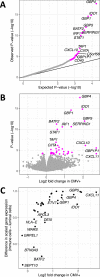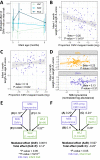Human cytomegalovirus in breast milk is associated with milk composition and the infant gut microbiome and growth
- PMID: 39043677
- PMCID: PMC11266569
- DOI: 10.1038/s41467-024-50282-4
Human cytomegalovirus in breast milk is associated with milk composition and the infant gut microbiome and growth
Abstract
Human cytomegalovirus (CMV) is a highly prevalent herpesvirus that is often transmitted to the neonate via breast milk. Postnatal CMV transmission can have negative health consequences for preterm and immunocompromised infants, but any effects on healthy term infants are thought to be benign. Furthermore, the impact of CMV on the composition of the hundreds of bioactive factors in human milk has not been tested. Here, we utilize a cohort of exclusively breastfeeding full-term mother-infant pairs to test for differences in the milk transcriptome and metabolome associated with CMV, and the impact of CMV in breast milk on the infant gut microbiome and infant growth. We find upregulation of the indoleamine 2,3-dioxygenase (IDO) tryptophan-to-kynurenine metabolic pathway in CMV+ milk samples, and that CMV+ milk is associated with decreased Bifidobacterium in the infant gut. Our data indicate two opposing CMV-associated effects on infant growth; with kynurenine positively correlated, and CMV viral load negatively correlated, with infant weight-for-length at 1 month of age. These results suggest CMV transmission, CMV-related changes in milk composition, or both may be modulators of full-term infant development.
© 2024. The Author(s).
Conflict of interest statement
The authors declare no competing interests.
Figures





Update of
-
Human Cytomegalovirus in breast milk is associated with milk composition, the infant gut microbiome, and infant growth.bioRxiv [Preprint]. 2023 Jul 19:2023.07.19.549370. doi: 10.1101/2023.07.19.549370. bioRxiv. 2023. Update in: Nat Commun. 2024 Jul 23;15(1):6216. doi: 10.1038/s41467-024-50282-4. PMID: 37503212 Free PMC article. Updated. Preprint.
References
-
- Hamprecht, K., Witzel, S., Maschmann, J., Speer, C. P. & Jahn, G. Transmission of cytomegalovirus infection through breast milk in term and pretern infants. In Short and long term effects of breast feeding on child health (eds. Koletzko, B., Michaelsen, K. F. & Hernell, O.) 231–239 (Springer US, Boston, MA, 2002).
MeSH terms
Substances
Grants and funding
LinkOut - more resources
Full Text Sources
Medical
Research Materials

